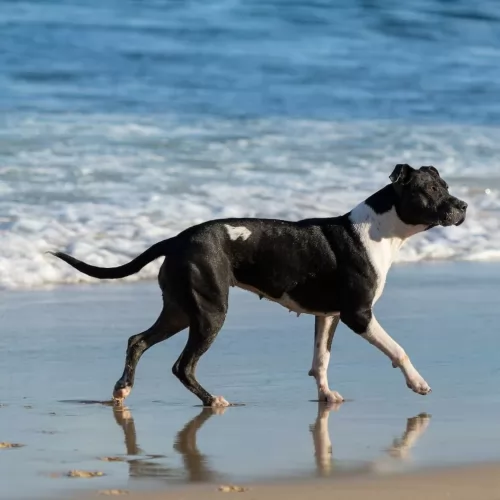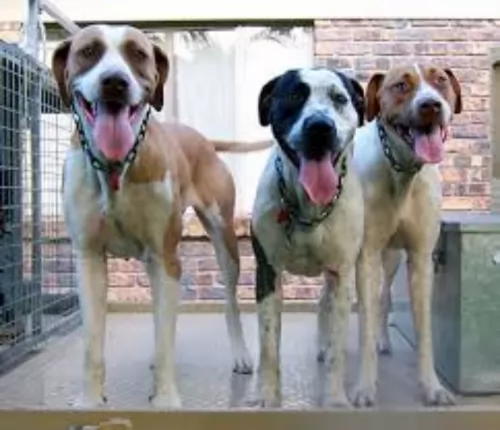 Petzlover
Petzlover Bull Arab is originated from Australia but Central Anatolian Shepherd is originated from Turkey. Bull Arab may grow 7 cm / 2 inches shorter than Central Anatolian Shepherd. Bull Arab may weigh 20 kg / 44 pounds lesser than Central Anatolian Shepherd. Both Bull Arab and Central Anatolian Shepherd has almost same life span. Both Bull Arab and Central Anatolian Shepherd has same litter size. Bull Arab requires Low Maintenance. But Central Anatolian Shepherd requires Moderate Maintenance
Bull Arab is originated from Australia but Central Anatolian Shepherd is originated from Turkey. Bull Arab may grow 7 cm / 2 inches shorter than Central Anatolian Shepherd. Bull Arab may weigh 20 kg / 44 pounds lesser than Central Anatolian Shepherd. Both Bull Arab and Central Anatolian Shepherd has almost same life span. Both Bull Arab and Central Anatolian Shepherd has same litter size. Bull Arab requires Low Maintenance. But Central Anatolian Shepherd requires Moderate Maintenance
 In the 1970’s feral pig hunters wanted a dog that could be aggressive in finding and capturing the pigs. The hunters crossed the German Shorthaired Pointer, the Bull Terrier and the Greyhound to develop the Bull Arab. It is believed that the hybrid is at least 50% Bull Terrier. It is also possible that there is some Doberman, Mastiff, Great Dane and/or Pointer in the hybrid as well.
In the 1970’s feral pig hunters wanted a dog that could be aggressive in finding and capturing the pigs. The hunters crossed the German Shorthaired Pointer, the Bull Terrier and the Greyhound to develop the Bull Arab. It is believed that the hybrid is at least 50% Bull Terrier. It is also possible that there is some Doberman, Mastiff, Great Dane and/or Pointer in the hybrid as well.
The job of the Bull Arab is to hunt out the feral pigs, grab one by the ear and hold it until the hunter arrives. They have a strong sense of smell and that is how they find the pigs.
Mike Hodgens, an Australian, developed the hybrid and added some Bloodhound as well to get that ability to smell out the pigs at great distances. They are also capable of catching buffalo and cattle. Some Australians use the breed in cattle or buffalo ranching. They are registered with the DRA or Dog Registry of America, Inc.
 The Central Anatolian Shepherd’s lineage is ancient, with the large dog originating from the Anatolia region of central Turkey. He has been used for guarding flocks against predatory wolves and has adapted to living in extreme weather conditions.
The Central Anatolian Shepherd’s lineage is ancient, with the large dog originating from the Anatolia region of central Turkey. He has been used for guarding flocks against predatory wolves and has adapted to living in extreme weather conditions.
The Turkish shepherds would put a spiked collar on the dog to protect him against predators going for the neck of the dog. Today the dog is still being used as a sheep dog and it is closely related to the Kangal Dog.
In 1965 the first pair of Anatolian Shepherds arrived in the UK. A pair were also provided by the Turkish prime minister to the United States government. Today he is a majestic dog still serving man. He is an Anatolian Shepherd Dog, a working dog breed, recognized by the American Kennel Club.
 Mike Hodgens succeeded in developing a powerful, well built dog. The Bull Arab has a powerful head and muzzle. He has moderate length drop ears and bright eyes that match the color of his coat. His chest is neither shallow nor deep and his back is straight and strong. Their tails are tapered and pointed yet the base is thick. They are a double-coated dog. They can be white with black, tan or liver, flecked or bicolor.
Mike Hodgens succeeded in developing a powerful, well built dog. The Bull Arab has a powerful head and muzzle. He has moderate length drop ears and bright eyes that match the color of his coat. His chest is neither shallow nor deep and his back is straight and strong. Their tails are tapered and pointed yet the base is thick. They are a double-coated dog. They can be white with black, tan or liver, flecked or bicolor.
 The Central Anatolian Shepherd is a large,impressive looking dog that possesses great strength, endurance and agility. He is beautiful to look at and is well muscled and strong.
The Central Anatolian Shepherd is a large,impressive looking dog that possesses great strength, endurance and agility. He is beautiful to look at and is well muscled and strong.
He stands at roughly 66-76 cm and weighs 40 to 70kg. The head is large and strong, but in good proportion with the rest of the dog’s body. He has brown eyes and his ears are floppy. The tail is long and set high and when the dog is alert, the tail is carried high, making a wheel shape, otherwise the tail is held low, curling up at the tip.
The short to medium length coarse coat is essentially fawn colored and the dog has a black mask. With the dog, early training and socialization will be needed as he is a strong, stubborn, dominant breed who will require firm leadership from his human owners.
The Central Anatolian Shepherd Dog is a loyal guard dog that becomes possessive over his flock, his human family and anything that he regards as his property. He is aloof around strangers, being suspicious of them.
He will require a firm, positive owner who provides training and socialization. He is an affectionate family pet and gets on well with children who have been taught how to treat dogs and other animals with care and respect. This is a bold, confident dog without aggression who is intelligent, proud and independent.
 The Bull Arab is intelligent, calm and loyal. Like Pit Bulls in the U.S., the Bull Arab has a reputation for aggression against both people and animals. There is no data to support these claims. They have been used as therapy dogs and companion animals very successfully. They are great with kids and very affectionate. The breed is cited as being used for companion and therapy animals
The Bull Arab is intelligent, calm and loyal. Like Pit Bulls in the U.S., the Bull Arab has a reputation for aggression against both people and animals. There is no data to support these claims. They have been used as therapy dogs and companion animals very successfully. They are great with kids and very affectionate. The breed is cited as being used for companion and therapy animals
 The large, rugged Anatolian Shepherd is a dog that has been developed essentially to work as a guardian of livestock. He is a dignified, calm kind of dog who is fiercely possessive of those he guards. He is independent and will require a firm, assertive owner.
The large, rugged Anatolian Shepherd is a dog that has been developed essentially to work as a guardian of livestock. He is a dignified, calm kind of dog who is fiercely possessive of those he guards. He is independent and will require a firm, assertive owner.
He won’t enjoy lying around the home with nothing to do. These are dogs who like to be busy, and therefore he is more a country-life dog than being found in the city on a small property. Make sure that if your pet hasn’t got a working role, that he is provided with exercise, although as a large dog, he isn’t particularly playful and doesn’t require loads of exercise.
Provide him with a caring, loving home and this large, beautiful dog will become your loyal and devoted friend who will guard you with his life.
 The Anatolian Shepherd Dog is a hardy, healthy dog who isn’t likely to get sick easily. The dog can live to be 11, 12, 13 years of age when he receives excellent care. Like any pure breed though, he is susceptible to hereditary disorders and some of the other common health issues.
The Anatolian Shepherd Dog is a hardy, healthy dog who isn’t likely to get sick easily. The dog can live to be 11, 12, 13 years of age when he receives excellent care. Like any pure breed though, he is susceptible to hereditary disorders and some of the other common health issues.
This condition is always a problem with a big dog. It’s an abnormal development of the hip joint and it can cause lameness and painful arthritis of the joints. It is brought about by a combination of environmental- as well as genetic factors.
This is a common type of blood cell cancer diagnosed in dogs. Lymphoid tissue is present in quite a few places in the body including lymph nodes, liver and spleen, and dogs of any age can be affected.
 This is a working dog so he needs to eat the right kind of quality dog food. In order to avoid bloat do not feed large meals but rather feed one to two cups of food two to three times a day.
This is a working dog so he needs to eat the right kind of quality dog food. In order to avoid bloat do not feed large meals but rather feed one to two cups of food two to three times a day.
Hunting Accidents – this is the biggest reasons for health problems with the Bull Arab.
These are working dogs that are inactive when not working. They need a lot of exercise if they are not used for hunting. Agility, Tracking and hunting games, and field trials.
 The Central Anatolian Shepherd sheds fairly heavily so he will require brushing at least twice a week. Grooming is important and won’t only include brushing, but ear cleaning and nail trimming too as well as proper dental hygiene.
The Central Anatolian Shepherd sheds fairly heavily so he will require brushing at least twice a week. Grooming is important and won’t only include brushing, but ear cleaning and nail trimming too as well as proper dental hygiene.
A dog such as the Anatolian Shepherd, with his floppy ears, will also need to have his ears checked and cleaned to avoid ear infections. There are some of these dogs where the hair needs to be plucked from the ear canal to ensure proper air circulation.
It is important that you are skilled to clean the ears properly, and if in any doubt, to avoid damage to the ear, consult your vet for sound advice.